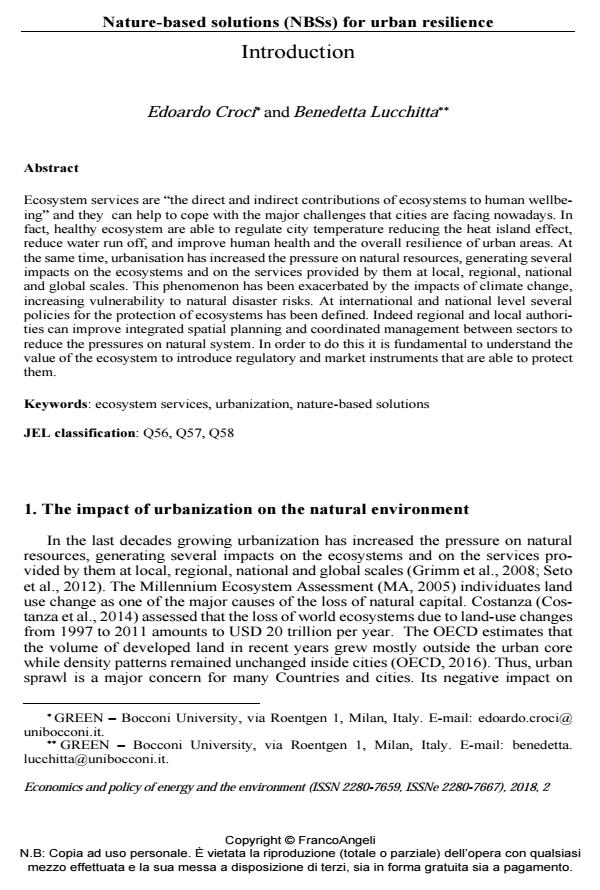Nature-based solutions (NBSs) for urban resilience. Introduction
Journal title ECONOMICS AND POLICY OF ENERGY AND THE ENVIRONMENT
Author/s Edoardo Croci, Benedetta Lucchitta
Publishing Year 2019 Issue 2018/2
Language English Pages 12 P. 31-42 File size 331 KB
DOI 10.3280/EFE2018-002002
DOI is like a bar code for intellectual property: to have more infomation
click here
Below, you can see the article first page
If you want to buy this article in PDF format, you can do it, following the instructions to buy download credits

FrancoAngeli is member of Publishers International Linking Association, Inc (PILA), a not-for-profit association which run the CrossRef service enabling links to and from online scholarly content.
Ecosystem services are "the direct and indirect contributions of ecosystems to human wellbeing" and they can help to cope with the major challenges that cities are facing nowadays. In fact, healthy ecosystem are able to regulate city temperature reducing the heat island effect, reduce water run off, and improve human health and the overall resilience of urban areas. At the same time, urbanisation has increased the pressure on natural resources, generating several impacts on the ecosystems and on the services provided by them at local, regional, national and global scales. This phenomenon has been exacerbated by the impacts of climate change, increasing vulnerability to natural disaster risks. At international and national level several policies for the protection of ecosystems has been defined. Indeed regional and local authorities can improve integrated spatial planning and coordinated management between sectors to reduce the pressures on natural system. In order to do this it is fundamental to understand the value of the ecosystem to introduce regulatory and market instruments that are able to protect them.
Keywords: Ecosystem services, urbanization, nature-based solutions
Jel codes: Q56, Q57, Q58
- Systematic Literature Review: Research Development of Urban Resilience in Metropolitan Areas Yudi Saptono, Ernan Rustiadi, Baba Barus, Andrea Emma Pravitasari, in Sustainability /2025 pp.7380
DOI: 10.3390/su17167380 - Valuing Ecosystem Services at the Urban Level: A Critical Review Edoardo Croci, Benedetta Lucchitta, Tommaso Penati, in Sustainability /2021 pp.1129
DOI: 10.3390/su13031129
Edoardo Croci, Benedetta Lucchitta, Nature-based solutions (NBSs) for urban resilience. Introduction in "ECONOMICS AND POLICY OF ENERGY AND THE ENVIRONMENT" 2/2018, pp 31-42, DOI: 10.3280/EFE2018-002002